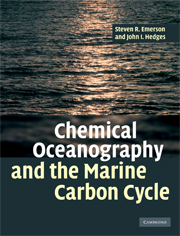Book contents
- Frontmatter
- Contents
- Preface
- Acknowledgements
- I Introduction to chemical oceanography
- II Advanced topics in marine geochemistry
- 8 Marine organic geochemistry
- 9 Molecular diffusion and reaction rates
- 10 Gases and air–water exchange
- 11 The global carbon cycle: interactions between the atmosphere and ocean
- 12 Chemical reactions in marine sediments
- Index
- Plate section
- References
11 - The global carbon cycle: interactions between the atmosphere and ocean
Published online by Cambridge University Press: 05 September 2012
- Frontmatter
- Contents
- Preface
- Acknowledgements
- I Introduction to chemical oceanography
- II Advanced topics in marine geochemistry
- 8 Marine organic geochemistry
- 9 Molecular diffusion and reaction rates
- 10 Gases and air–water exchange
- 11 The global carbon cycle: interactions between the atmosphere and ocean
- 12 Chemical reactions in marine sediments
- Index
- Plate section
- References
Summary
Cycling of carbon among the ocean, atmosphere and land is a fundamental component of the chemical perspective of oceanography because the fugacity () or partial pressure () of carbon dioxide is the most important greenhouse gas in the atmosphere (except for H2O, which behaves in a feedback rather than forcing capacity). Since there is about 50 times as much inorganic carbon dissolved in the sea as there is CO2 in the atmosphere, ocean carbonate chemistry has a great impact on in the atmosphere. On time scales of hundreds to a thousand years the main marine processes that influence in the atmosphere are the thermodynamic temperature dependence of CO2 solubility in seawater (the solubility pump), and the interplay between the rate of ocean circulation and the rate of biological carbon removal from the euphotic zone to the deeper reservoirs of the ocean (the biological pump). On longer time scales, of the order of one to tens of thousands of years, the preservation and dissolution of calcium carbonate along with the rate of weathering and the transport of bicarbonate to the sea come more into play.
The Earth is presently in the early stages of a grand acid–base titration of seawater by CO2. Anthropogenic CO2 is being added to the atmosphere at a rate fast enough to have resulted in an approximately 30% increase in the of the atmosphere since pre-industrial time.
- Type
- Chapter
- Information
- Chemical Oceanography and the Marine Carbon Cycle , pp. 372 - 403Publisher: Cambridge University PressPrint publication year: 2008



